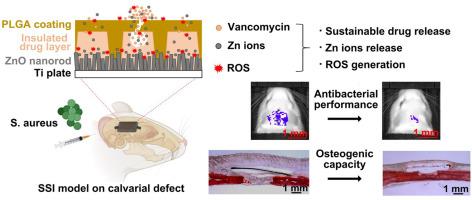钛植入物上的混合氧化锌纳米涂层:在感染性疾病中控制药物释放以增强抗菌和成骨性能
IF 9.4
1区 医学
Q1 ENGINEERING, BIOMEDICAL
引用次数: 0
摘要
植入物相关细菌感染是骨科植入物并发症的主要原因,而局部给药是一种有效的缓解策略。我们的研究小组从干燥土壤的形态中汲取灵感,开发出一种先进的药物输送系统,并将其添加到钛(Ti)板上。该系统将氧化锌(ZnO)纳米棒阵列与万古霉素药物层以及保护性聚乳酸-聚乙二醇酸(PLGA)涂层整合在一起。氧化锌纳米棒与药物之间的结合产生了附着的药物块,这些药物块被类似干燥的裂缝隔离,然后被聚乳酸(PLGA)包裹,从而实现药物的持续释放。此外,氧化锌纳米棒释放的锌离子和产生的活性氧(ROS)也增强了抗菌效果。氧化锌纳米棒-药物-PLGA 系统的抗菌特性已通过体外和体内研究得到验证。研究人员对细菌感染对骨缺损再生的影响以及这种给药系统在愈合过程中的作用进行了全面调查。此外,还分析了局部免疫反应,并证明了该系统的免疫调节功能。总之,研究结果表明,氧化锌纳米棒-药物-PLGA 系统具有卓越的性能,是一种高效、安全的抗植体相关细菌感染的方法。意义说明:植入物相关细菌感染是一项重大的临床挑战,尤其是在骨科手术中。为解决这一问题,我们开发了一种创新的 ZnO 纳米棒-药物-PLGA 系统,用于在传统钛植入物上局部输送抗生素。该系统可生物降解,具有独特的类似干燥的结构,能与氧化锌纳米棒释放的活性物质一起实现药物的持续释放。在金黄色葡萄球菌挑战的大鼠腓骨缺损模型中,我们的系统表现出了显著的抗菌效果,大大促进了骨缺损再生,并表现出了局部免疫调节作用,有助于感染控制和骨生成。这些突破性研究成果凸显了这种新型给药系统的巨大临床潜力,并为增强传统金属生物材料的功能引入了一种变革性的涂层策略。本文章由计算机程序翻译,如有差异,请以英文原文为准。

Hybrid zinc oxide nanocoating on titanium implants: Controlled drug release for enhanced antibacterial and osteogenic performance in infectious conditions
Implant-associated bacterial infections are a primary cause of complications in orthopedic implants, and localized drug delivery represents an effective mitigation strategy. Drawing inspiration from the morphology of desiccated soil, our group has developed an advanced drug-delivery system augmented onto titanium (Ti) plates. This system integrates zinc oxide (ZnO) nanorod arrays with a vancomycin drug layer along with a protective Poly(lactic-co-glycolic acid) (PLGA) coating. The binding between the ZnO nanorods and the drug results in attached drug blocks, isolated by desiccation-like cracks, which are then encapsulated by PLGA to enable sustained drug release. Additionally, the release of zinc ions and the generation of reactive oxygen species (ROS) from the ZnO nanorods enhance the antibacterial efficacy. The antibacterial properties of ZnO nanorod-drug-PLGA system have been validated through both in vitro and in vivo studies. Comprehensive investigations were conducted on the impact of bacterial infections on bone defect regeneration and the role of this drug-delivery system in the healing process. Furthermore, the local immune response was analyzed and the immunomodulatory function of the system was demonstrated. Overall, the findings underscore the superior performance of the ZnO nanorod-drug-PLGA system as an efficient and safe approach to combat implant-associated bacterial infections.
Statement of significance
Implant-associated bacterial infections pose a significant clinical challenge, particularly in orthopedic procedures. To address this, we developed an innovative ZnO nanorod-drug-PLGA system for local antibiotic delivery on conventional titanium implants. This system is biodegradable and features a unique desiccation-like structure that enables sustained drug release, along with the active substances released from the ZnO nanorods. In a rat calvarial defect model challenged with S. aureus, our system demonstrated remarkable antibacterial efficacy, significantly enhanced bone defect regeneration, and exhibited local immunomodulatory effects that support both infection control and osteogenesis. These breakthrough findings highlight the substantial clinical potential of this novel drug delivery system and introduce a transformative coating strategy to enhance the functionality of traditional metallic biomaterials.
求助全文
通过发布文献求助,成功后即可免费获取论文全文。
去求助
来源期刊

Acta Biomaterialia
工程技术-材料科学:生物材料
CiteScore
16.80
自引率
3.10%
发文量
776
审稿时长
30 days
期刊介绍:
Acta Biomaterialia is a monthly peer-reviewed scientific journal published by Elsevier. The journal was established in January 2005. The editor-in-chief is W.R. Wagner (University of Pittsburgh). The journal covers research in biomaterials science, including the interrelationship of biomaterial structure and function from macroscale to nanoscale. Topical coverage includes biomedical and biocompatible materials.
 求助内容:
求助内容: 应助结果提醒方式:
应助结果提醒方式:


